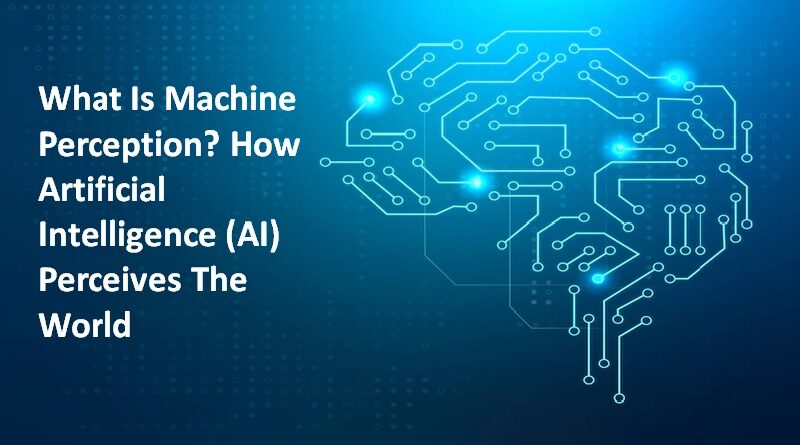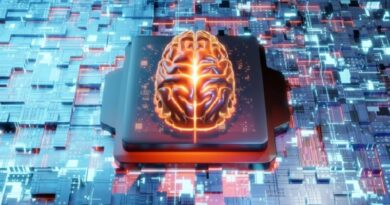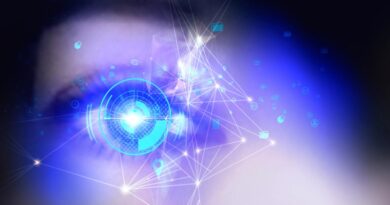What is Machine Perception? How Artificial Intelligence (AI) Perceives the World
Machine perception refers to a computer’s capacity to receive and process sensory data in a manner that is comparable to how people experience the environment. It may rely on sensors that imitate basic human senses including sight, sound, touch, and taste in addition to being able to process information differently from humans.
A machine’s ability to sense and analyze information typically requires specialized hardware and software. Raw data must first be ingested and then transformed or translated into the broad overview and precise selection of focus used by humans (and animals) to experience their environment.
Many of the sensory models for artificial intelligence (AI) start with perception. The algorithms take the information acquired from the outside environment and turn it into a basic representation of what is being observed. The subsequent stage, commonly referred to as cognition, involves developing a more comprehensive grasp of the external world. The next step is to plan and decide what to do.
In other circumstances, the objective is to simply get the robots to think similarly to people rather than to have them think exactly like humans. Because computers have access to more precise images or data than people can perceive, several algorithms for medical diagnosis may offer better solutions than humans. The objective is to provide helpful insights into the sickness that can aid human doctors and nurses, not to educate AI computers to think exactly like humans do. That is to say, it is acceptable—and occasionally even preferred—for a machine to interpret something differently than a human would.
Types of machine perception
Here some types of machine perception, in varying stages of development:
- Machine or computer vision via optical camera
- Machine hearing (computer audition) via microphone
- Machine touch via tactile sensor
- Machine smell (olfactory) via electronic nose
- Machine taste via electronic tongue
- 3D imaging or scanning via LiDAR sensor or scanner
- Motion detection via accelerometer, gyroscope, magnetometer or fusion sensor
- Thermal imaging or object detection via infrared scanner
Theoretically, machine perception refers to any direct, computer-based information gathering from the outside world.
Many of the areas where humans excel but where basic rules are difficult to encode are ones that are typically seen as obstacles to creating strong machine perception. Human handwriting, for instance, frequently differs from word to word. Humans can spot patterns, but because there are so many subtle differences between letters, it is more difficult to educate a computer to correctly identify them.
The many fonts and small printing changes might make it difficult to even interpret written text. For optical character recognition to work, the computer must be programmed to consider more general issues, such as the letter’s basic shape, and to adjust if the font stretches some of the aspects.
Some academics who study machine perception hope to create computer add-ons that can actually start to imitate how people perceive the world. Some people are developing electronic noses and tongues that approximate or perhaps exactly replicate the chemical processes that the human brain decodes.
In some situations, electronics provide superior sense to corresponding human organs. Many microphones can detect sound frequencies that are well outside the audible range of humans. They can also detect sounds that are too faint for humans to hear. The aim is to figure out how to have the computer perceive the world similarly to how a person does.
Some researchers studying machine perception concentrate on attempting to mimic how humans may focus on particular sounds. For instance, the human brain is frequently able to identify specific conversations in a noisy setting. Computers struggle to eliminate background noise because it requires them to pick out the important details from a sea of noise.
Which human senses do machines have a good mimic for?
Computers communicate to the outside world via a variety of sensors, but these sensors all operate differently from human sense organs, which also use a variety of sensors. Some are more precise and can gather more environmental data with higher accuracy. Others are less precise.
Thanks to advanced cameras and light-gathering optical lenses, machine vision may be the most potent sense. Special cameras can detect a larger range of colors, including some that the human eye is unable to see, despite the fact that many of these cameras are designed to mimic how the human eye responds to color. For instance, it’s common practise to check homes for heat leaks using infrared sensors.
It’s feasible for computers to discern tiny changes better than humans since the cameras are more sensitive to subtle variations in light intensity. For instance, cameras may detect a person’s heartbeat by picking up on the faint flush that results from blood streaming through face capillaries.
The next most effective form of machine perception is frequently sound. The microphones, especially the older ones, are tiny and frequently more sensitive than human ears. They have the ability to detect frequencies considerably outside the range of human hearing, giving computers the ability to hear events and monitor sounds that are incomprehensible to humans.
Additionally, microphones can be arranged in arrays so that the computer can track numerous ones at once and locate the source more accurately than a human could. Arrays using three or more microphones can produce more accurate estimations than two-eared humans.
Computers can detect touch, but typically only under unique conditions. Mobile devices’ touchscreens and touchpads can be quite accurate. Multiple fingers and minute movements are both detectable. In order for activities like a long touch or a brief tap to have distinct meanings, developers have worked to make it possible for these sensors to detect variations in contact duration.
It is less customary for developers of machine perception to focus on taste and smell. Because human senses are dependent on such intricate chemistry, there aren’t many sensors that make an attempt to imitate them. However, in certain labs, scientists have been able to dissect the procedures into small enough pieces that some artificial intelligence programmes can start to taste or smell.
Can a machine perceive things?
Scientists studying artificial intelligence rapidly discovered that some of the most straightforward tasks for humans may be excruciatingly challenging for computers to master. For instance, most of us automatically scan a room for a seat when we want to sit down. Robots still find the work challenging.
It is very simple to make computers function at adult levels on IQ tests or when playing checkers, yet it is difficult or impossible to give them one-year-old perception and mobility abilities, according to Hans Moravec’s description of the paradox from the 1980s.
People don’t always realise how hard their brains are working to understand their senses, which contributes to some of this. More than half of the brain, according to many brain experts, is thought to be engaged in processing what our eyes are seeing. At least in normal daylight, we frequently perceive things without actively choosing to search for them. Humans only look for visual hints regarding items and their potential locations when it is dark or foggy outside.
Machine perception encompasses more than simply machine vision, and researchers are still working to replicate even the most straightforward human tasks. When the algorithms function properly, they produce responses that are simple, mostly numerical, and frequently devoid of context or interpretation.
The sensors may be able to detect a red object at a certain point, but it is difficult to identify it or even tell if it is a component of another object.
How do rivals and startups approach machine perception?
Many businesses, including new and seasoned adversaries, are attempting to make their models behave like people.
Autonomous transportation is one use for which this is highly relevant. The AIs must comprehend the world like people do if they are to share the road with human drivers and pedestrians. Startups with considerable investment that are producing vehicles that are already on the streets of some cities include Waymo, Pony AI, Aeye, Cruise Automation, and Argo. They are integrating carefully designed AIs that can catalogue and avoid roadblocks.
Some startups are more interested in developing software that only tracks things and possible obstacles to autonomous motion. A few examples of businesses developing “perception stacks” to manage the data flowing from various sensors include aiMotive, StradVision, Phantom AI, and CalmCar.
These systems frequently outperform humans in a number of different ways. They occasionally rely on a system of cameras that can concurrently view 360 degrees all around the car. In other instances, they extract even more specific information about the location of objects using specialised controlled lights, such as lasers.
Some firms are tackling the difficulty of comprehending words and going beyond simple keyword searching. The businesses Blackbird.ai, Basis Technology, and Narrative Science (which is now a part of Tableau) are fantastic instances of when looking to identify the motivation behind the author of the text. They discuss moving beyond just picking out the keywords to picking out narratives.
Some researchers are trying to find a technique to predict human behaviour by examining for visual cues. By creating a predictive model of people from a video feed, Humanising Autonomy aims to lower liability and eliminate accidents.
Some businesses concentrate on finding solutions to specific real-world issues. For instance, AMP Robotics is developing sorting equipment that can extract recyclable elements from trash streams. To mimic human sorting behaviour, these computers employ machine vision and learning algorithms.
Some people are merely using AI to improve human experience by comprehending human perception. For instance, Pensa Systems employs video cameras to inspect store shelves and search for subpar displays. By enhancing visibility and positioning, this “shelf intelligence” seeks to make it simpler for customers to find what they want.
What is the limit of machine perception?
Humans and computers think in different ways. Simple mathematical calculations and memorising lengthy lists of numbers or letters come naturally to them. Finding a set of algorithms that enables them to perceive the environment as humans do in terms of sight, sound, and touch is more difficult.
Success levels can vary. Some activities are surprisingly complex and challenging, like identifying objects in a photograph and differentiating between them. The algorithms that machine vision researchers have developed can function, but they are still vulnerable and prone to errors that a young child wouldn’t make.
This is mostly due to the lack of sound, rational models for how we perceive the world. Humans can easily define something like a chair, but teaching a computer to differentiate between a stool and a low table is difficult.
The most effective algorithms frequently rely heavily on statistics. The complicated, adaptive statistical models that the machine learning systems compute from a large amount of data occasionally produce the correct answer. Many of the classification methods that can identify items in an image are built on these machine learning techniques and neural networks.
These statistical methods are merely approximations notwithstanding their success. They resemble parlour tricks more. They simulate human thought processes but do not genuinely think in the same manner. Because of this, it is very challenging to forecast when they may fail.
Algorithms for machine perception are generally helpful, although they will occasionally make errors and give inaccurate findings. This is mostly because our understanding of human perception is limited. Physics and psychology have provided us with some useful logical building blocks, but they are only the beginning. Since we don’t fully understand how people view the world, we must currently make due with statistical models.
It’s sometimes wise to concentrate more on the things that machines are better at. For example, many cameras and image sensors are capable of detecting light at wavelengths that are invisible to the human eye. For instance, the Webb Space Telescope only uses infrared light to function. The visuals we view are altered by computers so that they appear in hues that are visible. These researchers built a telescope that expanded human vision to include objects that would not normally be visible, rather than creating a device that could replicate what human perception was capable of.




